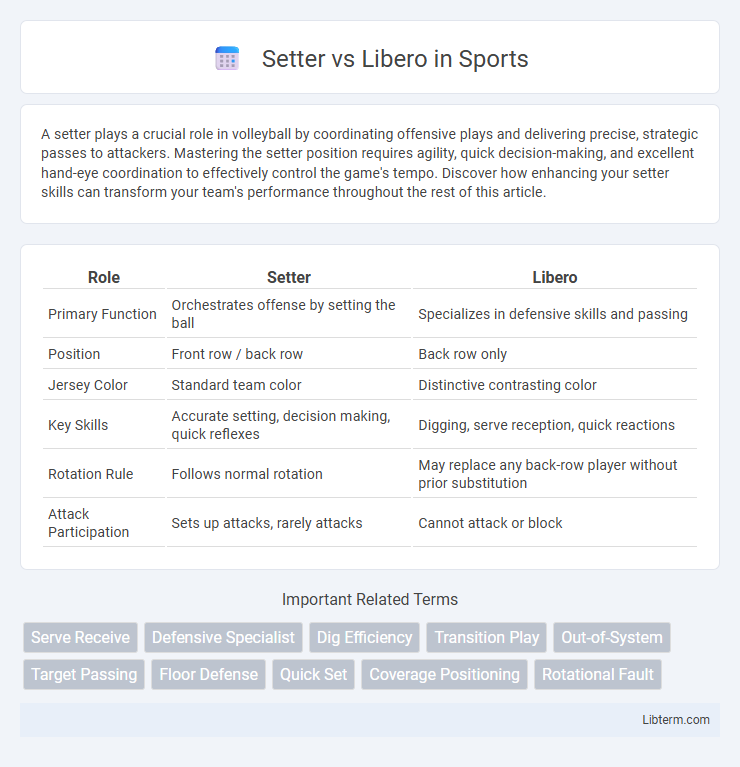A setter plays a crucial role in volleyball by coordinating offensive plays and delivering precise, strategic passes to attackers. Mastering the setter position requires agility, quick decision-making, and excellent hand-eye coordination to effectively control the game's tempo. Discover how enhancing your setter skills can transform your team's performance throughout the rest of this article.
Table of Comparison
| Role | Setter | Libero |
|---|---|---|
| Primary Function | Orchestrates offense by setting the ball | Specializes in defensive skills and passing |
| Position | Front row / back row | Back row only |
| Jersey Color | Standard team color | Distinctive contrasting color |
| Key Skills | Accurate setting, decision making, quick reflexes | Digging, serve reception, quick reactions |
| Rotation Rule | Follows normal rotation | May replace any back-row player without prior substitution |
| Attack Participation | Sets up attacks, rarely attacks | Cannot attack or block |
Introduction to Setter and Libero Roles
The setter orchestrates the offense by delivering precise sets to hitters, acting as the team's playmaker and requires exceptional ball-handling skills and court vision. The libero specializes in defensive stability, wearing a different color jersey and excelling in digs, passes, and serve receive to maintain ball control. Both roles are crucial in volleyball strategy, with the setter driving scoring opportunities and the libero fortifying the team's defense.
Key Responsibilities of a Setter
A setter orchestrates the offensive play by delivering precise and well-timed sets to attackers, ensuring optimal positioning for scoring opportunities. They must have exceptional ball-handling skills and quick decision-making to read the opposing defense and adjust plays accordingly. Unlike a libero who specializes in defensive digs and passing, the setter acts as the team's offensive strategist, controlling the tempo and flow of the match.
Primary Duties of a Libero
The primary duties of a libero include receiving serves with precision, executing accurate passes to the setter, and providing consistent defense through digs during rallies. Liberos specialize in back-row defense and are restricted from attacking or blocking, enhancing team stability and ball control. Their role is crucial for maintaining seamless ball transitions and enabling offensive plays through strategic positioning and quick reactions.
Skillset Comparison: Setter vs Libero
Setters excel in precise ball placement and strategic playmaking, utilizing advanced hand positioning and spatial awareness to create scoring opportunities, whereas liberos specialize in exceptional defensive skills such as quick reflexes, accurate digging, and consistent serve receive. The setter's skillset emphasizes agility and decision-making to control the offense, while the libero focuses on stability and anticipation to enhance team defense. Both roles require superior ball control but diverge in their primary functions: the setter orchestrates attacks, and the libero safeguards the backcourt.
Positional Requirements and Restrictions
The setter must have precise ball-handling skills and quick decision-making abilities to orchestrate offensive plays, positioned near the net to deliver accurate sets, with restrictions against attacking from the front zone on a back-row set. The libero specializes in defensive skills, particularly in digging and receiving serves, restricted from attacking, blocking, or serving, typically positioned in the back row to maximize ball control and coverage. These positional roles require adherence to strict volleyball rules regarding rotation and contact to maintain tactical balance and effectiveness on the court.
Impact on Team Strategy
The setter acts as the primary playmaker in volleyball, orchestrating offensive strategies by delivering precise sets that enable hitters to execute successful attacks. The libero specializes in defensive skills, enhancing the team's reception and digging capabilities, which stabilizes serve receive and facilitates effective counterattacks. Together, the setter's offensive orchestration and the libero's defensive proficiency create a balanced team dynamic that optimizes both scoring opportunities and defensive resilience.
Physical and Mental Attributes Needed
Setters require exceptional agility, quick reflexes, and strong hand-eye coordination to deliver precise ball placement under pressure, alongside sharp decision-making and leadership skills to orchestrate team offense effectively. Liberos demand superior speed, endurance, and flexibility to execute rapid defensive movements and digs, coupled with heightened situational awareness and mental resilience to maintain focus during high-stress rallies. Both positions rely heavily on strong communication abilities and mental toughness to adapt to dynamic gameplay scenarios.
Training and Development for Setters and Liberos
Setters prioritize training that enhances hand-eye coordination, quick decision-making, and precise ball placement through repetitive drills and strategic scenario simulations. Liberos focus on agility, reflexes, and defensive positioning, with development routines emphasizing reaction time, diving techniques, and passing accuracy under pressure. Both positions benefit from specialized conditioning programs that improve stamina and court awareness tailored to their unique roles on the volleyball team.
Common Myths about Setter and Libero Positions
The setter is often mistakenly thought to only perform quick sets, while in reality, they also manage game tempo and strategic ball distribution. Many assume liberos solely focus on digging, but they play a critical role in serve reception and back-row defense coordination. Both positions demand high game intelligence and versatility beyond their stereotypical roles.
Choosing Between Setter or Libero: Which Suits You?
Choosing between a setter and a libero depends on your skill set and game preferences; setters excel in strategic ball distribution and require precise hand coordination, while liberos specialize in defensive skills and quick reflexes for effective digs and passes. Consider your physical agility, anticipation ability, and communication skills, as setters must coordinate offensive plays, and liberos anchor consistent defensive stability. Understanding these roles helps determine which position aligns best with your strengths and contributes effectively to your volleyball team's success.
Setter Infographic

 libterm.com
libterm.com